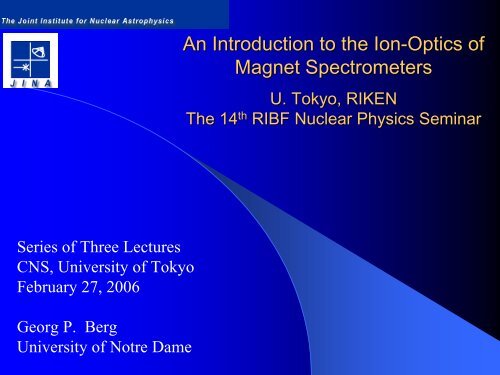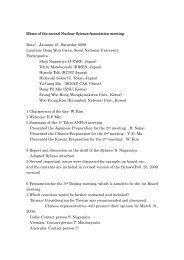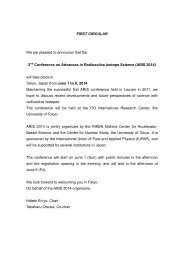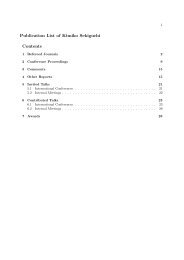An Introduction to the Ion-Optics of Magnet Spectrometers
An Introduction to the Ion-Optics of Magnet Spectrometers
An Introduction to the Ion-Optics of Magnet Spectrometers
You also want an ePaper? Increase the reach of your titles
YUMPU automatically turns print PDFs into web optimized ePapers that Google loves.
<strong>An</strong> <strong>Introduction</strong> <strong>to</strong> <strong>the</strong> <strong>Ion</strong>-<strong>Optics</strong> <strong>of</strong><br />
<strong>Magnet</strong> <strong>Spectrometers</strong><br />
U. Tokyo, RIKEN<br />
The 14 th RIBF Nuclear Physics Seminar<br />
Series <strong>of</strong> Three Lectures<br />
CNS, University <strong>of</strong> Tokyo<br />
February 27, 2006<br />
Georg P. Berg<br />
University <strong>of</strong> Notre Dame
The Lecture<br />
Series<br />
1 st Lecture: 2/27/06, 10:30 am: Formalism <strong>of</strong> ion-optics optics and design<br />
<strong>of</strong> a complete system<br />
2 nd Lecture: 2/27/06, 1:30 pm: <strong>Ion</strong>-optical optical elements, design, systems<br />
3 rd Lecture: 2/27/06, 3:00 pm: Experiments with dispersion matched<br />
high resolution spectrometers
1st Lecture<br />
1 st Lecture: 2/27/06, 10:30 – 11:30 am: Formalism and ion-optical optical elements<br />
• Motivation, references, remarks (4 - 8)<br />
• The driving forces (9)<br />
• Definitions & first order formalism (10 - 16)<br />
• Phase space ellipse, emittance, measurement (17 - 27)<br />
• Higher orders, Taylor expansion (28 - 30)<br />
• Solving <strong>the</strong> equation <strong>of</strong> motion (31)<br />
• Design and construction <strong>of</strong> a Fragment Separa<strong>to</strong>r (32 - 43)
Motivation<br />
• Manipulate charged particles (β +/− , ions, like p,d,α, ΗΙ)<br />
• Beam lines systems<br />
• <strong>Magnet</strong>ic & electric analysis/ separation (Experiments!)<br />
• (Acceleration <strong>of</strong> ions, not covered in <strong>the</strong>se lectures)
Who needs ion-optics optics ?<br />
• A group <strong>of</strong> accelera<strong>to</strong>r physicists are using it <strong>to</strong> build machines<br />
<strong>to</strong> provide high energetic ion beam for research and applications!<br />
• Many physicists using accelera<strong>to</strong>rs, beam lines and magnet system<br />
(or <strong>the</strong>ir data) needs some knowledge <strong>of</strong> ion-optics.<br />
• This lecture series is an introduction <strong>to</strong> <strong>the</strong> last group and I will<br />
discuss some applications used by nuclear physicists.
Introduc<strong>to</strong>ry remarks<br />
• <strong>Introduction</strong> for physicists Focus on ion-optical definitions, and <strong>to</strong>ols that<br />
are useful for physicist working with spectrometers.<br />
• Light optics can hardly be discussed without lenses & optical instruments<br />
ion-optics requires knowledge <strong>of</strong> ion-optical elements.<br />
• <strong>An</strong>alogy between Light <strong>Optics</strong> and <strong>Ion</strong>-<strong>Optics</strong> is useful but limited.<br />
• <strong>Ion</strong>-optical & magnet design <strong>to</strong>ols needed <strong>to</strong> understand electro-magnet systems.<br />
<strong>Ion</strong>-optics is not even 100 years old and (still) less intuitive than optics developed<br />
since several hundred years<br />
His<strong>to</strong>rical remarks:<br />
Ru<strong>the</strong>rford, 1911, discovery <strong>of</strong> a<strong>to</strong>mic nucleus<br />
Galileo<br />
Telescope 1609 <br />
<strong>Optics</strong> in Siderus Nuncius 1610
Basic <strong>to</strong>ols <strong>of</strong> <strong>the</strong> trade<br />
• Geometry, drawing <strong>to</strong>ols, CAD drafting program (e.g. Au<strong>to</strong>Cad)<br />
• Linear Algebra (Matrix calculations), first order ion-optics (e.g. TRANSPORT)<br />
• Higher order ion-optics code <strong>to</strong> solve equation <strong>of</strong> motion, e.g. COSY Infinity,<br />
GIOS, RAYTRACE (his<strong>to</strong>ric)<br />
• Electro-magnetic field program (solution <strong>of</strong> Maxwell’s Equations),<br />
(e.g. finite element (FE) codes, 2d & 3d: POISSON, TOSCA, MagNet)<br />
• Properties <strong>of</strong> incoming charged particles and design function <strong>of</strong> electro-magnetic<br />
facility, beam, reaction products (e.g. kinematic codes, charge distributions <strong>of</strong><br />
heavy ions, energy losses in targets, detec<strong>to</strong>rs, etc, e.g. LISE++ for fragment<br />
separa<strong>to</strong>rs)<br />
• Many o<strong>the</strong>r specialized programs, e.g. for accelera<strong>to</strong>r design (e.g. synchrotrons,<br />
cyclotrons) or gas-filled systems, are not covered in this lecure series.
Literature<br />
• <strong>Optics</strong> <strong>of</strong> Charged Particles, Hermann Wollnik, Academic Press, Orlando, 1987<br />
• The <strong>Optics</strong> <strong>of</strong> Charged Particle Beams, David.C Carey, Harwood Academic<br />
Publishers, New York 1987<br />
• Accelera<strong>to</strong>r Physics, S.Y. Lee, World Scientific Publishing, Singapore, 1999<br />
• TRANSPORT, A Computer Program for Designing Charged Particle Beam<br />
Transport Systems, K.L. Brown, D.C. Carey, Ch. Iselin, F. Rotacker,<br />
Report CERN 80-04, Geneva, 1980<br />
• Computer-Aided Design in <strong>Magnet</strong>ics, D.A. Low<strong>the</strong>r, P. Silvester, Springer 1985
<strong>Ion</strong>s in static or quasi-static static electro-magnetic fields<br />
Lorentz Force<br />
For ion acceleration electric forces are used.<br />
(1)<br />
q = electric charge<br />
B = magn. induction<br />
E = electric field<br />
v = velocity<br />
For momentum analysis <strong>the</strong> magnetic force is preferred because <strong>the</strong><br />
force is always perpendicular <strong>to</strong> B. Therefore v, p and E are constant.<br />
Force in magnetic dipole B = const: p = q B ρ<br />
p = mv = momentum<br />
Dipole field B<br />
perpendicular<br />
.<br />
<strong>to</strong> paper plane<br />
Object (size x 0 )<br />
Radius<br />
ρ<br />
p+δp<br />
p<br />
x<br />
Note: Dispersion δx/δp<br />
used in magnetic analysis,<br />
e.g. <strong>Spectrometers</strong>, magn.<br />
Separa<strong>to</strong>rs,<br />
ρ = bending radius<br />
Βρ = magn. rigidity<br />
General rule:<br />
Scaling <strong>of</strong> magnetic system<br />
in <strong>the</strong> linear region results<br />
in <strong>the</strong> same ion-optics
Definition <strong>of</strong> BEAM for ma<strong>the</strong>matical formulation <strong>of</strong> ion-optics<br />
optics<br />
What is a beam, what shapes it,<br />
how do we know its properties ?<br />
• Beam parameters, <strong>the</strong> long list<br />
• Beam rays and distributions<br />
• Beam line elements, paraxial lin. approx.<br />
higher orders in spectrometers<br />
• System <strong>of</strong> diagnostic instruments<br />
Not <strong>to</strong> forget: A<strong>to</strong>mic charge Q<br />
Number <strong>of</strong> particles n
Code TRANSPORT:<br />
(x, Θ, y, Φ, 1, dp/p)<br />
(1, 2, 3, 4, 5, 6 )<br />
Convenient “easy <strong>to</strong> use” program<br />
for beam lines with paraxial beams<br />
Not defined in <strong>the</strong> figure are:<br />
dp/p = rel. momentum<br />
l = beam pulse length<br />
Defining a RAY<br />
central ray<br />
<strong>Ion</strong>-optical<br />
element<br />
All parameters are relative<br />
<strong>to</strong> “central ray”<br />
Code: COSY Infinity:<br />
(x, a, y, b, l, δ K , δ m , δ z )<br />
Needed for complex ion-optical systems including several<br />
charge states<br />
different masses<br />
velocities (e.g. Wien Filter)<br />
higher order corrections<br />
Not defined in <strong>the</strong> figure are:<br />
δ K = dK/K = rel. energy<br />
δ m = dm/m = rel. energy<br />
δ z = dq/q = rel. charge change<br />
a = p x /p 0<br />
b = p y /p 0<br />
All parameters are relative<br />
<strong>to</strong> “central ray” properties<br />
Note: Notations in <strong>the</strong> Literature is not consistent! Sorry, nei<strong>the</strong>r will I be.
TRANSPORT<br />
Coordinate System<br />
<br />
Ray at initial<br />
Location 1
6x6 Matrix<br />
representing<br />
optic element<br />
(first order)<br />
Transport <strong>of</strong> a ray<br />
<br />
(2)<br />
<br />
Ray after<br />
element at<br />
Location t<br />
<br />
Ray at initial<br />
Location 0<br />
Note: We are not building<br />
“random” optical elements.<br />
Many matrix elements = 0<br />
because <strong>of</strong> symmetries, e.g.<br />
mid-plane symmetry
TRANSPORT matrices <strong>of</strong> a<br />
Drift and a Quadrupole<br />
For reference <strong>of</strong> TRANSPORT code and formalism:<br />
K.L. Brown, F. Rothacker, D.C. Carey, and Ch. Iselin,<br />
TRANSPORT: A computer program for designing<br />
charged particle beam transport systems, SLAC-91,<br />
Rev. 2, UC-28 (I/A), also: CERN 80-04 Super Pro<strong>to</strong>n<br />
Synchrotron Division, 18 March 1980, Geneva,<br />
Manual plus Appendices available on Webpage:<br />
ftp://ftp.psi.ch/psi/transport.beam/CERN-80-04/<br />
David. C. Carey, The optics <strong>of</strong> Charged Particle Beams,<br />
1987, Hardwood Academic Publ. GmbH, Chur Switzerland
6x6 Matrix<br />
representing<br />
first optic element<br />
(usually a Drift)<br />
Transport <strong>of</strong> a ray<br />
though a system <strong>of</strong><br />
beam line elements<br />
<br />
x n = R n R n-1 …R 0 x 0<br />
(3)<br />
<br />
Ray at final<br />
Location n<br />
<br />
Ray at initial<br />
Location 0<br />
(e.g. a target)<br />
Complete system is represented by<br />
one Matrix R system = R n R n-1 …R 0<br />
(4)
Wollnik, p. 16<br />
(x|a) = 0<br />
Point-<strong>to</strong>-point focusing<br />
(a|x) = 0 “Telescope”<br />
Parallel-<strong>to</strong>-parallel focusing<br />
Geometrical interpretation<br />
<strong>of</strong> some TRANSPORT<br />
matrix elements<br />
Achromatic system:<br />
R 16 = R 26 = 0<br />
(x|x) = 0<br />
Parallel-<strong>to</strong>-point focusing<br />
(a|a) = 0<br />
Point-<strong>to</strong>-parallel focusing<br />
Focusing Function<br />
(x|a) Wollnik<br />
= dx/dΘ physical meaning<br />
= (x|Θ) RAYTRACE<br />
= R 12 TRANSPORT
Defining a BEAM Ellipse Area = π(det σ) 1/2<br />
is called “Phase space”<br />
Emittance:<br />
ε = √⎯⎯⎯⎯⎯⎯⎯⎯⎯⎯⎯ σ 11 σ 22 -(σ 12 ) 2 (5)<br />
2 dimensional cut x-Θ is shown<br />
Emittance ε is constant for<br />
fixed energy & conservative<br />
forces (Liouville’s Theorem)<br />
Warning:<br />
This is a ma<strong>the</strong>matical abstraction <strong>of</strong> a beam:<br />
It is your responsibility <strong>to</strong> verify it applies <strong>to</strong> your beam<br />
Note: ε shrinks (increases) with<br />
acceleration (deceleration); Dissipative<br />
forces: ε increases in gases; electron,<br />
s<strong>to</strong>chastic, laser cooling<br />
Attention:<br />
Space charge effects occur when <strong>the</strong> particle density is high,<br />
so that particles repel each o<strong>the</strong>r
Equivalence<br />
<strong>of</strong> Transport <strong>of</strong><br />
ONE Ray ⇔ Ellipse<br />
Defining <strong>the</strong> σ Matrix representing a Beam
The 2-dimensional 2<br />
case ( x, Θ )<br />
Ellipse Area = π(det σ) 1/2<br />
Emittance ε = (det σ) 1/2 is constant<br />
for fixed energy & conservative<br />
forces (Liouville’s Theorem)<br />
Note: ε shrinks (increases) with<br />
acceleration (deceleration);<br />
Dissipative forces: ε increases in<br />
gases; electron, s<strong>to</strong>chastic, laser<br />
cooling<br />
σ = ⎛σ 11 σ 21 ⎫<br />
⎝σ 21 σ 22 ⎭<br />
σ −1 = 1/ε 2 ⎛σ 22 −σ 21 ⎫<br />
⎝−σ 21 σ 11 ⎭<br />
Exercise 1:<br />
Show that:<br />
2 dimensional cut x-Θ is shown<br />
Real, pos. definite<br />
symmetric σ Matrix<br />
σσ −1 = ⎛1 0 ⎫<br />
⎝ 0 1⎭<br />
Inverse Matrix<br />
= I (Unity Matrix)<br />
2-dim. Coord. vec<strong>to</strong>rs<br />
(point in phase space)<br />
X =<br />
⎛x ⎫<br />
X T = (x Θ)<br />
⎝Θ⎭<br />
Ellipse in Matrix notation:<br />
X T σ −1 X = 1<br />
(6)<br />
Exercise 2: Show that Matrix notation<br />
is equivalent <strong>to</strong> known Ellipse equation:<br />
σ 22 x 2 −2σ 21 x Θ + σ 11 Θ 2 = ε 2
Courant-Snyder Notation<br />
In <strong>the</strong>ir famous “Theory <strong>of</strong> <strong>the</strong> Alternating Synchrotron” Courant and Snyder used a<br />
Different notation <strong>of</strong> <strong>the</strong> σ Matrix Elements, that are used in <strong>the</strong> Accelera<strong>to</strong>r Literature.<br />
For you r future venture in<strong>to</strong> accelera<strong>to</strong>r physics here is <strong>the</strong> relationship between <strong>the</strong><br />
σ matrix and <strong>the</strong> betatron amplitude functions α, β, γ or Courant Snyder parameters<br />
σ =<br />
⎛σ 11 σ 21 ⎫<br />
⎝σ 21 σ 22 ⎭<br />
= ε<br />
⎛ β −α ⎫<br />
⎝−α γ ⎭
Transport <strong>of</strong> 6-dim 6<br />
σ Matrix<br />
Consider <strong>the</strong> 6-dim. ray vec<strong>to</strong>r in TRANSPORT: X = (x, Θ, y, Φ, l, dp/p)<br />
Ray X 0 from location 0 is transported by a 6 x 6 Matrix R <strong>to</strong> location 1 by: X 1 = RX 0<br />
(7)<br />
Note: R maybe a matrix representing a complex system (3) is : R = R n R n-1 …R 0<br />
Ellipsoid in Matrix notation (6), generized <strong>to</strong> e.g. 6-dim. using σ Matrix: X 0<br />
T<br />
σ 0<br />
−1<br />
X 0 = 1<br />
Inserting Unity Matrix I = RR -1 in equ. (6) it follows X 0<br />
T<br />
(R T R T-1 ) σ 0<br />
−1<br />
(R -1 R) X 0 = 1<br />
from which we derive (RX 0 ) T (Rσ 0 R T ) -1 (RX 0 ) = 1<br />
(6)<br />
(8)<br />
The equation <strong>of</strong> <strong>the</strong> new ellipsoid after transformation becomes X 1<br />
T<br />
σ 1<br />
−1<br />
X 1 = 1<br />
(9)<br />
where σ 1 = Rσ 0 R T (10)<br />
Conclusion: Knowing <strong>the</strong> TRANSPORT matrix R that transports one<br />
ray through an ion-optical system using (7) we can now also transport<br />
<strong>the</strong> phase space ellipse describing <strong>the</strong> initial beam using (10)
The transport <strong>of</strong> rays and phase ellipses<br />
in a Drift and focusing Quadrupole, , Lens<br />
Focus<br />
Focus<br />
2.<br />
Lens 2<br />
3.<br />
Lens 3<br />
Matching <strong>of</strong> emittance and acceptance
Increase <strong>of</strong> Emittance ε<br />
due <strong>to</strong> degrader<br />
Focus<br />
for back-<strong>of</strong>-<strong>the</strong>-envelop discussions!<br />
A degrader / target increases <strong>the</strong><br />
emittance ε due <strong>to</strong> multiple scattering.<br />
The emittance growth is minimal when<br />
<strong>the</strong> degrader in positioned in a focus<br />
As can be seen from <strong>the</strong> schematic<br />
drawing <strong>of</strong> <strong>the</strong> horizontal x-Theta<br />
Phase space.
Emittance ε measurement<br />
by moving viewer method<br />
The emittance ε is an important<br />
parameter <strong>of</strong> a beam. It can be<br />
determined by measurements<br />
<strong>of</strong> x max<br />
at 3 locations<br />
Viewer V1 V2 V3<br />
Beam<br />
⎯⏐⎯⎯⎯⏐⎯⎯⎯⎯⏐⎯→<br />
L 1 L 2<br />
L = Distances between viewers<br />
( beam pr<strong>of</strong>ile moni<strong>to</strong>rs)<br />
σ 11 + 2 L 1 σ 12 + L 2<br />
(x max (V2)) 2 = 1 σ 22<br />
(11)<br />
(x max (V3)) 2 = σ 11 + 2 (L 1 + L 2 )σ 12 + (L 1 + L 2 ) 2 σ 22<br />
where σ 11 = (x max (V1)) 2<br />
Emittance:<br />
ε = √ ⎯⎯⎯⎯⎯⎯⎯⎯⎯⎯⎯ σ 11 σ 22 -(σ 12 ) 2<br />
(12)<br />
Discuss practical aspects<br />
No ellipse no ε? Phase space!
Emittance ε measurement<br />
by tuning a quadrupole<br />
Lee, p. 55<br />
The emittance ε can also be<br />
determined with a quadrupole<br />
and a viewer at distance L.<br />
x max =<br />
σ 11 (1 + σ 12 L/ σ 11 − L g) + (εL) 2 /σ 22<br />
(13)<br />
g =<br />
dBz/dx ∗ l<br />
Bρ<br />
(Quadr. field strength<br />
l = eff. field length)<br />
(14)<br />
L = Distance between quadrupole and<br />
beam pr<strong>of</strong>ile moni<strong>to</strong>r<br />
Take minimum 3 measurements <strong>of</strong><br />
x max (g) and determine Emittance ε
IUCF, K600 Spectrometer<br />
Diagnostics in focal plane<br />
<strong>of</strong> spectrometer<br />
Typical in focal plane <strong>of</strong><br />
Modern <strong>Spectrometers</strong>:<br />
Two position sensitive<br />
Detec<strong>to</strong>rs:<br />
Horizontal: X1, X2<br />
Vertical: Y1, Y2<br />
Fast plastic scintilla<strong>to</strong>rs:<br />
Particle identification<br />
Time-<strong>of</strong>-Flight<br />
Measurement with IUCF K600<br />
Spectrometer illustrates from <strong>to</strong>p<br />
<strong>to</strong> bot<strong>to</strong>m: focus near, downstream<br />
and upstream <strong>of</strong><br />
X1 detec<strong>to</strong>r, respectively
Kinematic affect in K600<br />
spectrum with impurities
Higher order beam aberrations<br />
Example Octupole<br />
(S-shape in x-Θ plane<br />
3 rays in focal plane<br />
1.<br />
2.<br />
3.<br />
Detec<strong>to</strong>r X1 X2<br />
T 126<br />
T 1222<br />
1.<br />
2.<br />
3.<br />
O<strong>the</strong>r Example:<br />
Sextupole T 122<br />
C-shape in x-Θ plot
Effect <strong>of</strong> 2 nd order aberrations<br />
Saturation <strong>of</strong><br />
Grand Raiden<br />
at 450 MeV<br />
(3He,t)
,l<br />
(15)<br />
Taylor expansion<br />
Note: Several notations are in use for<br />
6 dim. ray vec<strong>to</strong>r & matrix elements.<br />
R nm<br />
= (n|m)<br />
TRANSPORT RAYTRACE<br />
Notation<br />
Linear (1 st order)TRANSPORT Matrix R nm<br />
Remarks:<br />
• Midplane symmetry <strong>of</strong> magnets<br />
reason for many matrix element = 0<br />
• Linear approx. for “well” designed<br />
magnets and paraxial beams<br />
• TRANSPORT code calculates 2 nd order<br />
by including Tmno elements explicitly<br />
• TRANSPORT formalism is not suitable<br />
<strong>to</strong> calculate higher order ( >2 ).
(15)<br />
Solving <strong>the</strong> equations<br />
<strong>of</strong> Motion<br />
Methods <strong>of</strong> solving <strong>the</strong> equation <strong>of</strong> motion:<br />
1) Determine <strong>the</strong> TRANSPORT matrix.<br />
2) Code RAYTRACE slices <strong>the</strong> system in small<br />
sections along <strong>the</strong> z-axis and integrates numerically<br />
<strong>the</strong> particle ray through <strong>the</strong> system.<br />
3) Code COSY Infinity uses Differential Algebraic<br />
techniques <strong>to</strong> arbitrary orders using matrix<br />
representation for fast calculations
Design <strong>of</strong> a Fragment Separa<strong>to</strong>r Define <strong>the</strong> purpose and design parameters<br />
This step in <strong>the</strong> design determines what <strong>the</strong> instrument will be able <strong>to</strong> do:<br />
Particle type, energy, acceptances<br />
Now you need a good “concept”
Schematic Layout<br />
<strong>of</strong> an<br />
Achromatic <strong>Magnet</strong><br />
System
<strong>An</strong> Achromatic<br />
Energy Selection System<br />
(ESS in Pro<strong>to</strong>n Therapy<br />
Facility)<br />
R 16 = R 26 = 0
Achromatic magnet separa<strong>to</strong>r with Wedge<br />
↓ “Wedge” = 0.1 mm “Si=detec<strong>to</strong>r”<br />
A<br />
^<br />
E-loss in WEDGE ΔE ~ Z 2 /v 2<br />
Iso<strong>to</strong>pes with different Z have<br />
different velocities v<br />
Therefore A/Z selection in B<br />
B<br />
Figure from Experimental Techniques at NSCL, MSU, Th. Baumann, 8/2/2002<br />
Effect <strong>of</strong> “Wedge” ⇒<br />
Note:<br />
For large dp/p) <strong>the</strong><br />
degrader should be<br />
Wedge-shaped <strong>to</strong><br />
res<strong>to</strong>re achromaticity<br />
effected by degrader<br />
with constant thickness
A1900 MSU/NSCL Fragment Separa<strong>to</strong>r<br />
Ref. B.Sherrill, MSU
Design <strong>of</strong> a Fragment Separa<strong>to</strong>r 1 st order envelop <strong>of</strong> beam line & magnet system<br />
Calculated with<br />
TRANSPORT<br />
This study determines <strong>the</strong> ion-optics & required fields:<br />
Dispersion, envelops with dp=0, 2.6%<br />
Horz. & vert. Good-field regions, Field Lengths, Strengths
TRIμP an achromatic secondary beam separa<strong>to</strong>r<br />
SH = Slits<br />
Q = Quadrupoles<br />
B = Dipoles<br />
Section B<br />
Wedge/ΔE-Si<br />
Design parameters<br />
Section A<br />
ΔE-Si detec<strong>to</strong>r<br />
meter
TRIμP ion-optics<br />
optics<br />
This study determines <strong>the</strong> final performance including higher orders:<br />
Details <strong>of</strong> rays, focal plane image<br />
Write “Specifications” for manufacturer
TRIμP<br />
<strong>Magnet</strong> Installation &Alignment<br />
December 2003
Intermediate, dispersive Focal<br />
Plane<br />
BEAM
Commissioning<br />
( TRIμP Production <strong>of</strong> clean radioactive beam <strong>of</strong> 21 Na)<br />
Production <strong>of</strong> 21 Na via H( 21 Ne,n) 21 Na with<br />
21<br />
Ne 7+ beam at 43MeV/nucleon using<br />
<strong>the</strong>TRIμP Separa<strong>to</strong>r, KVI Groningen.
The First Users at <strong>the</strong><br />
TRIμP Separa<strong>to</strong>r<br />
Precision measurement <strong>of</strong> GTbranching<br />
ratio in 21 Na b + decay<br />
21<br />
Na<br />
b +<br />
0.0004%<br />
94.98%<br />
5.02%<br />
352 keV<br />
21<br />
Ne<br />
g<br />
Lynda Achouri (See proposal <strong>to</strong> this PAC)<br />
Jean-Claude <strong>An</strong>gélique<br />
both LPC, CAEN, France
End Lecture 1








